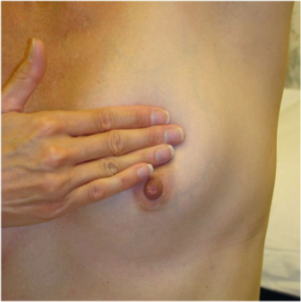|
OBGYN Skills Lab
|
|||||||||
|
Avoiding Self Breast Exam Errors Video Self breast exam comprised one portion of the classic triad of early detection of breast abnormalities, the other two being regular professional breast exams and screening mammography. It has been widely recommended and widely practiced for many years. Recently, the value of self breast examination has been questioned because:
That said, not everyone is in agreement with those conclusions, and so for those who wish to perform self breast examination, this is how to do it.
To watch the video, click here Breast self exam can be a useful tool for detection of breast cancer. The best results are achieved when errors are avoided. The breasts consist of milk glands and ducts, but most of the breast is fat tissue. This gives the breast a somewhat nodular, or tapioca-like consistency. Breast size, density and nodularity vary with the menstrual cycle. Ovulation usually occurs about two weeks before the onset of the menstrual flow. The time from ovulation to menstruation is not the best time for self breast exam, because the breasts may be naturally thick and nodular. The first few days after menstruation is the best time for self breast examination. During pregnancy, breasts grow in size and density, making detection of abnormalities more difficult. There is a bowl-like depression underneath the nipple. While sensisitive, you should be sure to feel this area during the exam. While breasts are generally symmetrical, they are not usually identical in size, shape or position. While some people think of the breast as round, with the nipple in the middle, breast tissue is found more widely on the chest wall and extends into the armpit. The boundaries are from the middle of the armpit, to the bottom of the breast, to the breastbone, up to the collar bone, across the collar bone, and back to the armpit. This forms an uneven pentagon. While looking in the mirror, make sure to check the skin of each breast for color or contour changes. You are less likely to miss these changes if you raise your arms over your head while watching. Alternatively, put your hands on your hips and squeeze them together while you watch. It's important not to miss any breast tissue. One way to accomplish this is the use of the vertical strip method. Make small circles, following the vertical strip pattern. Start in the armpit and work your way down. When you get to the bottom of your breast, move your hand over toward your breast bone and start back up again. This is the pattern you'll be following. Disregard the normal breast nodularity. You are feeling for a mass that is separate against the background nodularity. Some people describe this as feeling for a marble in a bag of rice. Underneath the breast are ribs. Don't mistake them accidentally for a mass. Lymph nodes are normally too small to be felt, but if enlarged, you may be able to feel them in the armpit or around the collar bone. Don't use the palm of your hand for exams. It is too insensitive and you are too likely to miss things. For the same reason, don't use just a single finger. Instead, use this portion of your hand. Use a systematic approach so that the entire breast is examined. This type of unsystematic approach will likely miss important findings. Some abnormalities are best felt with light pressure, others with moderate pressure and some with firm pressure. If you ever find a lump, bring it to the attention of a professional right away. |
||||||||
|
This information is provided by The Brookside Associates, a private organization, not affiliated with any governmental agency. The opinions presented here are those of the author and do not necessarily represent the opinions of the Brookside Associates. For educational simplicity, only one method is usually shown, but many alternative methods may give satisfactory or superior results. This information is provided solely for educational purposes. The practice of medicine and surgery is regulated by statute and restricted to licensed professionals and those in training under supervision. Performing these procedures outside of that setting is a bad idea, is not recommended, and may be illegal. The presence of any advertising on these pages does not constitute an endorsement of that product or service by the Brookside Associates. C. 2010 All Rights Reserved |
|||||||||
 This is the Archived Desktop Edition.
This is the Archived Desktop Edition. 